Restaurant cleaning isn’t at the top of anyone’s list. But it is essential for a number of reasons. First and foremost, if you don’t keep up with your restaurant cleaning, you may run afoul of the Health Department. No one wants that. Especially now that services like Yelp are adding health inspection scores to online reviews. Yikes!
But perhaps even more important is the impression that a clean restaurant makes on your customers. Subtle cues about how clean or dirty your restaurant is can leave a lasting impression on your customers.
And you certainly don’t want to become a restaurant that makes people sick either. Especially during the colder months, proper restaurant cleaning is essential in helping to curb the spread of all sorts of disease-causing organisms.

Before we get to the specifics, let’s talk about restaurant cleaning in general. First, you need to have a plan. If you do not properly manage your restaurant’s maintenance and cleaning, it is much less likely to get done properly. At a very basic level, create a schedule of all the areas that need cleaning. And then assign specific individuals to conduct the cleaning. It really doesn’t have to be any harder than that.
However, just asking an employee to clean something may not be enough. Certain areas or pieces of equipment may require special instructions to clean properly. Having good cleaning documentation and doing periodic training with your employees is essential.
And of course, you will need the appropriate janitorial supplies and equipment. Having the right cleaning products and chemicals for different jobs not only helps ensure that your cleaning is done right but it also makes it easier for your employees. So let’s dive into those neglected areas that you probably need to clean right now!
>> Shop All Janitorial Supplies & Equipment >>
1. Can Openers
Can openers are a staple of food preparation. And often, what is inside those giant cans ends up on the blade and handle. The contents of these cans is most often a food product. And food products can become a health hazard when left uncleaned on a surface even for short periods of time.
Can openers get used frequently as well. This means that you can end up with cross-contamination too. All very bad stuff.
But fortunately, it is fairly easy to clean and maintain your can opener. The main piece to be concerned about is the blade. The blade is the part that cuts into the can itself. Because it punctures the can, the blade often comes into contact with the content of the can. But with a little care, you can keep your can opener like new.
Most can openers (like the Edlund model shown in the video below) come apart easily and most are dishwasher safe. A little attention to detail when cleaning will go a long way when it comes to keeping your can opener from being a grimy mess.
Care & cleaning of one of the most popular Edlund can openers
>> Shop All Can Openers >>
2. Soda Fountain Dispenser Nozzles
It doesn’t matter if your soda fountain is customer-facing or if your employees fill drinks for your customers. The dispenser nozzles (the place where the drink comes out into the cup) can get nasty very quickly. And because the syrup used is basically a sugar solution, it is an excellent medium for the growth of all sorts of unwanted organisms that love to feed on the sugary syrup.
Coca-Cola, one of the world’s largest suppliers of soda fountains to the restaurant industry provides extensive guidelines on the maintenance and cleaning of your soda fountain. Although some tasks are recommended for a weekly or monthly cleaning schedule, the dispenser should be cleaned daily according to their advice.
“Implementing thorough sanitary practices leaves a good impression with guests,” says Therron Foley, director of the Foodservice Quality Group, Coca-Cola North America. “And, a solid routine ensures your dispenser pours quality tasting beverages every time.”
The cleaning guide starts with some excellent advice: Wash your hands.
It’s a simple thing that often goes overlooked. Washing your hands helps to avoid cross-contamination.
The actual process of cleaning the dispenser is pretty straightforward. First, remove the nozzles and diffusers from the unit. Clean them with a brush to remove any material that has dried on to them. They recommend using a chlorine-based sanitizer to scrub the pieces and then to use as a soak for at least 3 minutes.
Rinse them, let them dry and replace them on the unit. Simple, right?
Coca-Cola also recommends daily cleaning of the exterior of the dispenser including the drip pan and the ice chute. They also recommend emptying and cleaning the ice bin with special attention to the sides of the ice bin. Ice machines and bins are notorious for developing “slime.” More on that in a bit.
| BONUS TIP | |
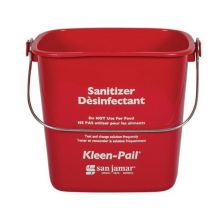 |
It’s a good practice to use color-coded buckets for sanitizers and cleaning like this red sanitizer bucket from San Jamar. This helps to avoid accidental mixing of harmful chemicals or contaminating clean rinse water. |
3. Menus
A restaurant menu is often an essential part of the overall dining experience. Some establishments go to great lengths to create the perfect menu as a showcase for all their wonderful meals.
But menus might be the single greatest disease vector in a restaurant. They get handled by tons of people and they rarely get replaced or cleaned.
Studies have shown that the germs that cause colds and flus can survive on hard surfaces for 18 hours or more. So you may not be just handling the germs of the last person to touch your menu. You could be handling the germs of everyone that has held that menu over the last day or more!
Good Morning America investigated and found that restaurant menus can contain 100 times more bacteria than the restaurant’s toilet seats. In fact, they swabbed menus and found an average of 185,000 bacteria on the surfaces.
So what can you do?
If your menu is plain paper, be sure to replace them often. There is no easy way to disinfect paper without messing up the menu appearance.
But there are alternatives. First, you could laminate your menu. But that can get expensive and cumbersome, especially if you change your menu frequently. As an alternative, consider a menu cover.
A plastic or vinyl menu cover may be just the thing to preserve your beautiful menu and to help keep your customers healthy.
Menu covers can be cleaned and sanitized fairly easily. Because of their frequent use and high propensity to retain germs and bacteria, menus in covers may need to be cleaned several times per shift. At minimum, they should be cleaned thoroughly each day.
>> Shop All Menu Accessories >>

4. High Chairs & Booster Seats
We love babies and children. But let’s be honest: kids are mobile disease vectors that can infect everything they touch.
High chairs and booster seats can be some of the filthiest things in a restaurant. And many restaurants don’t have a good plan for cleaning and disinfecting these pieces.
And to top it off, high chairs can be complicated to clean properly. These chairs can be made of different materials include wood, plastic, and metal. In addition, some high chairs can have a fabric covering component. Each of these materials may require different cleaning strategies.
If there is an eating tray, that should be the primary focus of your cleaning efforts. These are typically made of plastic and can be cleaned and disinfected pretty easily. These trays need to be thoroughly cleaned after every use.
Wooden chairs need to be cleaned regularly. A diluted solution of bleach or vinegar can be used. Be sure to check with the manufacturer for their recommendations for cleaning the product.
But if your high chair has fabric, you’ll want to skip the bleach obviously.
One of the most challenging parts to clean is the restraint system. Made of nylon straps and plastic clasps typically, it can be quite difficult to get debris out of all the nooks and crannies. This is challenging enough when the debris is just simple foodstuffs. But when the mess involves bodily fluids (not uncommon unfortunately) then it crosses over from being difficult to potentially dangerous.
So take extra special care to thoroughly clean your high chairs and booster seats. The only thing worse than getting a reputation for making your customers sick is when those customers are babies.
| BONUS TIP | |
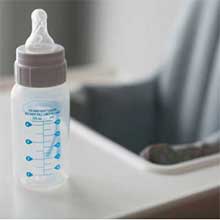 |
High chair standards are being updated for 2019. Get all the information and be sure you are up to code by checking out our article on the new High Chair Standards. Better to be prepared than to have a safety incident involving a child. |
5. Ice Accessories
Ice machines have a notorious reputation for being dirty and hard to clean. While modern ice makers have gotten much better at helping restaurants keep them clean and safe, any piece of equipment that is left uncared for can become a cleanliness nightmare. Ice machines are no exception.
Many resources will tell you that you need to empty and clean your ice maker’s bin each and every day. Unfortunately, if your restaurant is open for more than 12 hours a day, starting each day with an empty ice bin may be a problem. Depending on your machine, you may not be able to produce enough ice in time to cover demand.
However, that doesn’t mean that you should never clean the bin. You definitely should. It’s one of the places that health inspectors review closely and it can easily get you a bad grade on their report.
Follow your machine manufacturers instructions on cleaning the bin and do it as often as you can. A weekly schedule is probably appropriate for most businesses.
But there is another aspect to the humble ice machine that often goes overlooked: The ice scoop.
Whether they are metal or plastic, ice scoops come into contact with workers’ hands and can become the source of problems once inserted into the ice itself. Given their proximity to things like soda fountains and other food materials, ice scoops can get cross-contaminated pretty easily.
Fortunately, this is an easy problem to solve. Ice scoops should be washed daily. Most are dishwasher safe. And an even better practice would be to swap the scoop out once per shift.
The same advice follows for any other accessories you use to produce, move or serve ice to your customers. For example, many restaurants have a large commercial ice maker in back and then move ice from there to individual bins or serving stations. This is often done with a bucket or other large container. These containers need to be cleaned daily as well to avoid problems.
6. Everything on the Tabletop
We saved the best/worst for last. The bad news is that nearly everything that sits on a restaurant tabletop is a candidate for germs, bacteria and general grossness.
Let’s start with the salt and pepper shakers. No one thinks about these things, but they come into contact with a lot of hands. And with their proximity to foodstuffs, they get filthy pretty easily.
According to that same GMA study we mentioned earlier, the pepper shaker was the second germiest thing they found.
Unfortunately, salt and pepper shakers are very difficult to clean. Truly, the only way to really be sure that you are thoroughly cleaning these items is to have two sets of shakers. You can take the product out of the old shakers (if it is not visibly contaminated) and pour it into the clean shakers. Then run the dirty shakers through the dishwasher to disinfect. Lather, rinse, repeat….hopefully on a weekly basis, at least.
This is a laborious, manual process and you rarely hear of restaurants employing this kind of rigor. But if you aren’t doing something to clean the shakers, it’s a safe bet that they are gross.
Speaking of gross, I was in a pizza place once and observed a child shaking the Parmesan cheese into his mouth and licking the top. I told the waitress about this after the family left, thinking that she would remove the shaker. Nope. She wiped it with a dish rag and put it back. I visibly shuddered.
Crusty Condiment Containers
Another culprit on the tabletop are condiment dispensers. The humble ketchup bottle is notorious for being a germy mess. And again, these are not easy to clean. Sure, you can wipe down the outside, but we all know that under the lid is where the crusty stuff forms. Using a squeeze bottle can help. But even with that, you need to make sure you are completely emptying the container and running it through the dishwasher regularly. Ketchup is especially bad because of the high sugar/fructose content in most ketchup recipes. As we’ve noted before, germy bugs and other nasty things love sugary substrates to grow on.
Bottom line: try to clean everything on the tabletop regularly.
*Bonus Future Worry: Touchscreens & Kiosks
This might seem a way off for some, but the future is actually already here. In our increasingly self-service world, kiosks and other touchscreens are becoming commonplace in the restaurant industry. They are used for ordering, tabletop entertainment and paying the tab. And they can be germy messes.
A recent story out of the UK found that every touchscreen ordering kiosk that they tested at McDonald’s restaurants tested positive for fecal bacteria.
QSRWeb, a publication serving the quick service restaurant industry, investigated this issue and called for new sanitation guidelines to cover this emerging trend.
“There are all these kiosks that people touch all the time. The awareness around (what) the sanitation looks like is really important,” says Crystal Swanson of CSA Service Solutions.
So as you can see, this is an ever-evolving area for the foodservice industry. One that requires us all to remain vigilant and make changes as needed to protect our customers and our employees.
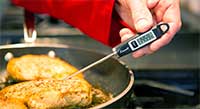 Test Your Knowledge!
Test Your Knowledge!
Whether you are an expert or a novice on food safety, you may just learn a thing or two from our Food Safety Quiz.

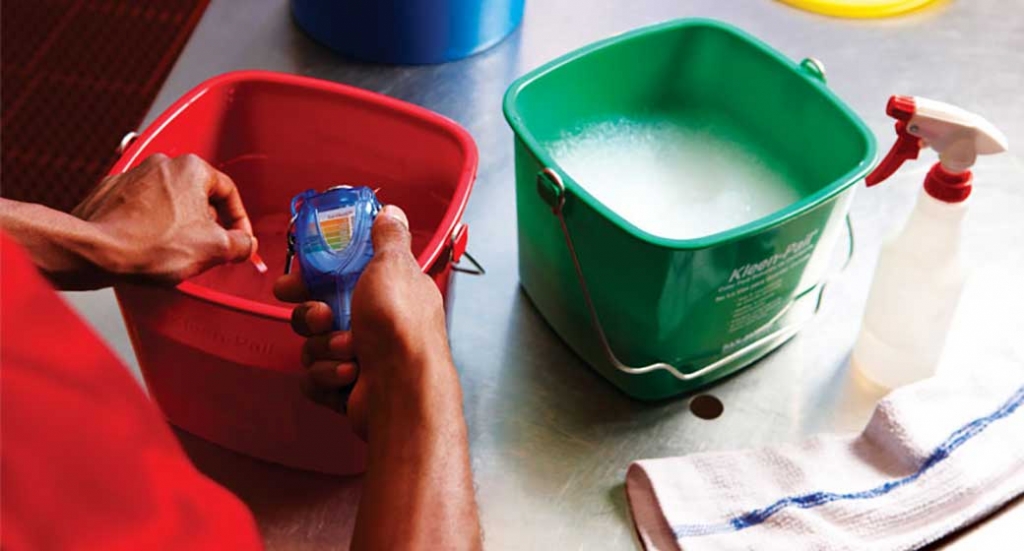




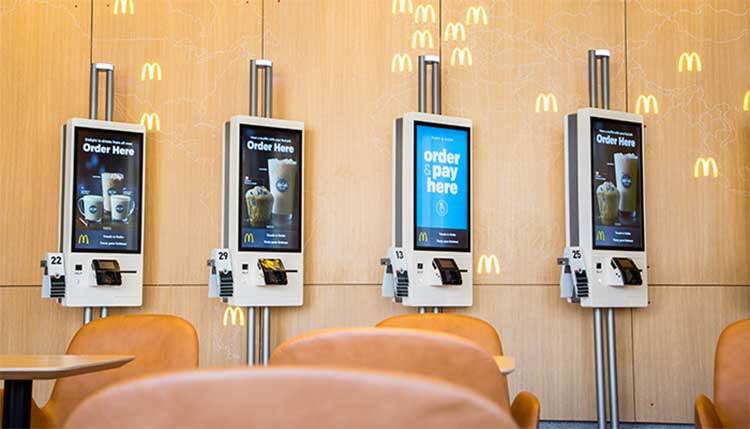

4 Cost-effective Ways to Improve Customer Experience at Your Restaurant - businesstimesnow
4 Cost-effective Ways to Improve Customer Experience at Your Restaurant - Techiestate
Thank you for providing such detailed information and guidelines. The best way to clean this stuff is HEAT There are three methods of using heat to sanitize surfaces – steam, hot water, and hot air. Hot water is the most common method used in restaurants.
Thank you for providing such detailed information and guidelines. There are two basic principles in all cleaning; pH and physical removal. Physical removal is one of the best microbial decontamination processes. It lessens the number of pathogens from all surfaces as well as removes the food sources that aid in their growth.
Great post! Thank you for providing all of this helpful information. Your blog is recommended, keep it up.. Very helpful and informative.
Very informative post! This blog information was very helpful, your blog is recommended. Keep it up.
Hello, all this information was very helpful. Thank you very much! Keep posting such kind of info on your blog. I’m really impressed by it.